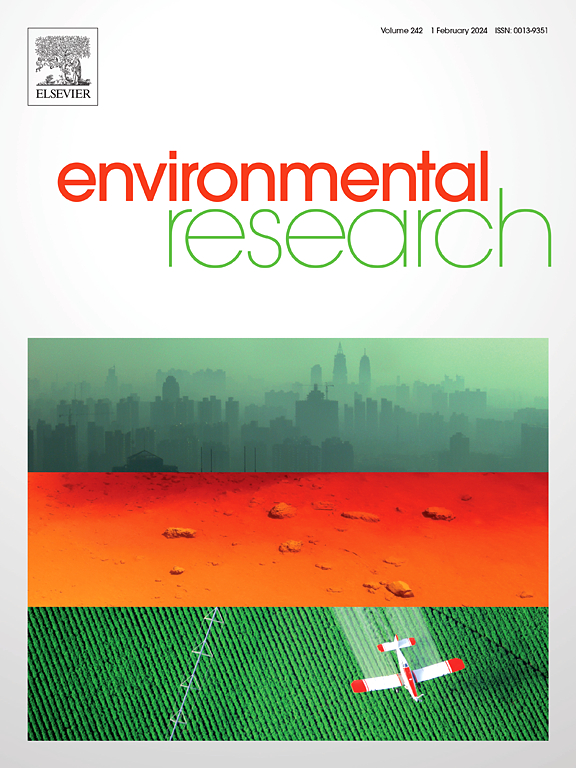Decadal variability and anthropogenic influence on trace element dynamics in the Bay of Bengal: Evidence from high-resolution coral records
IF 7.7
2区 环境科学与生态学
Q1 ENVIRONMENTAL SCIENCES
引用次数: 0
Abstract
The Bay of Bengal (BoB) exhibits dynamic trace element (TE) chemistry shaped by a complex interplay of natural processes and anthropogenic influences. Despite its significance, the temporal variability of TEs in this region is poorly understood. This study investigates decadal (2011–2022) TE dynamics by analyzing trace element-to-calcium ratios (TEs/Ca: B/Ca, Mn/Ca, Fe/Ca, Ba/Ca, P/Ca, As/Ca, Zn/Ca, Cd/Ca, and Sn/Ca) and strontium-to-calcium (Sr/Ca) ratios in modern Porites corals, supplemented by data from a sub-fossil coral as a benchmark. The results reveal distinct seasonal cycles in B/Ca, Sr/Ca, and Ba/Ca, with B/Ca and Sr/Ca being predominantly controlled by sea surface temperature (SST), while Ba/Ca variability is influenced by terrestrial inputs associated with river discharge. B/Ca has been validated as a reliable SST proxy for riverine runoff-influenced BoB. Elevated Fe/Ca, Mn/Ca, and As/Ca ratios are associated with anthropogenic activities, such as the construction of significant infrastructure projects (e.g., Padma Multipurpose Bridge, Payra Sea Port, and Matarbari Deep Sea Port) and the establishment of the Rohingya refugee camp. Additionally, increases in P/Ca, Zn/Ca, and Cd/Ca reflect intensified fertilizer use, whereas rising Sn/Ca levels suggest inputs from antifouling agents, pesticides, and tourism. Principal component analysis combined with multiple linear regression (PCA-MLR) indicates that anthropogenic activities account for approximately 70 % of the TE variability. These findings underscore the significant role of human activities in altering the TE dynamics in the BoB, providing valuable insights for coastal management and pollution mitigation strategies in similarly impacted regions worldwide.
孟加拉湾微量元素动态的年代际变化和人为影响:来自高分辨率珊瑚记录的证据
孟加拉湾(BoB)表现出由自然过程和人为影响的复杂相互作用形成的动态微量元素(TE)化学。尽管具有重要意义,但人们对该地区TEs的时间变异性知之甚少。本研究通过分析现代Porites珊瑚中微量元素-钙比率(TEs/Ca: B/Ca, Mn/Ca, Fe/Ca, Ba/Ca, P/Ca, As/Ca, Zn/Ca, Cd/Ca和Sn/Ca)和锶-钙比率(Sr/Ca),并辅以亚化石珊瑚的数据作为基准,研究了年代际(2011-2022)TE动态。结果表明,B/Ca、Sr/Ca和Ba/Ca具有明显的季节变化周期,其中B/Ca和Sr/Ca主要受海温控制,而Ba/Ca则受河流流量等陆地输入的影响。B/Ca已被证实为河流径流影响的BoB的可靠SST代理。铁/钙、锰/钙和砷/钙比值的升高与人为活动有关,例如重大基础设施项目的建设(如帕德玛多用途桥、帕拉海港和马塔巴里深水港)和罗兴亚难民营的建立。此外,P/Ca、Zn/Ca和Cd/Ca的增加反映了肥料使用的强化,而Sn/Ca水平的上升表明防污剂、农药和旅游业的投入。主成分分析结合多元线性回归(PCA-MLR)表明,人为活动约占总变率的70%。这些研究结果强调了人类活动在改变东北纬带TE动态方面的重要作用,为全球受类似影响地区的沿海管理和污染缓解战略提供了宝贵的见解。
本文章由计算机程序翻译,如有差异,请以英文原文为准。
求助全文
约1分钟内获得全文
求助全文
来源期刊

Environmental Research
环境科学-公共卫生、环境卫生与职业卫生
CiteScore
12.60
自引率
8.40%
发文量
2480
审稿时长
4.7 months
期刊介绍:
The Environmental Research journal presents a broad range of interdisciplinary research, focused on addressing worldwide environmental concerns and featuring innovative findings. Our publication strives to explore relevant anthropogenic issues across various environmental sectors, showcasing practical applications in real-life settings.
 求助内容:
求助内容: 应助结果提醒方式:
应助结果提醒方式:


